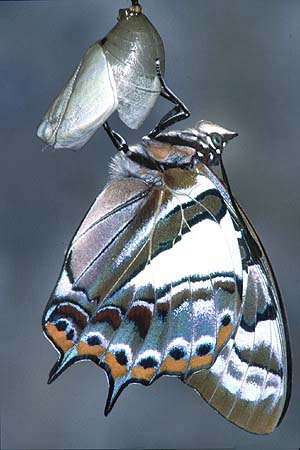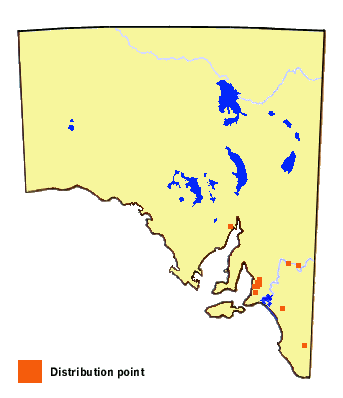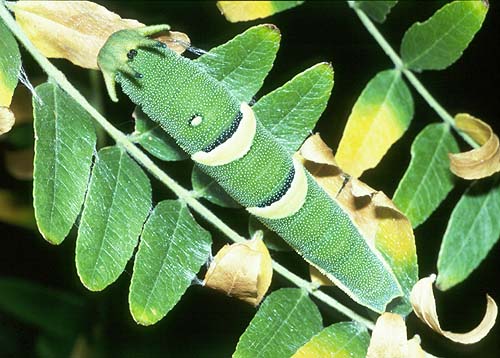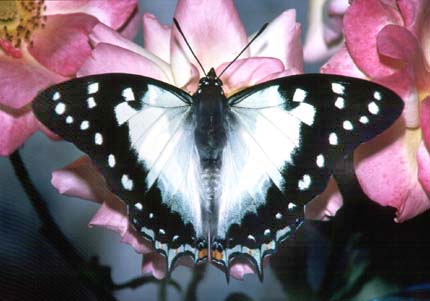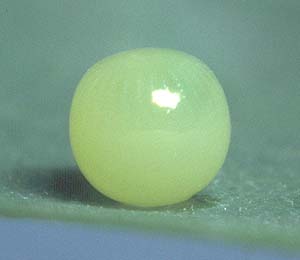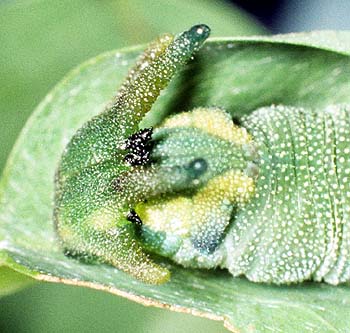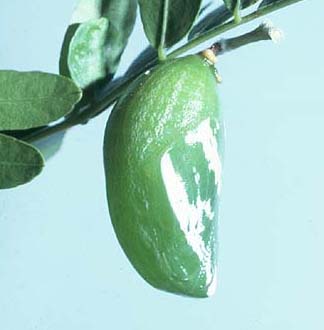Initially pale yellow with some short, white coloured secondary setae, arising from
pale coloured raised bases. The neck area behind the head is reddish brown. After
eating the green leaves of the hostplant, the larva gradually turns green (after 2
days), although the posterior portion of the larva always remains yellow. The larva
tapers posteriorly ending with a deeply divided fork, tipped white. The head is
mostly black coloured with some yellowish brown frontal markings, large, rounded,
granulose, with some short hairs and spiny protuberances, and with two pairs of
bowed tapering horns, the more dorsal pair being the longest, which are white tipped.
There is a further very short dorsal pair. The larva emerges from the egg with the
head horns and tail fork being pale pinkish coloured, and are short, soft and pliable.
The horns and tail fork are quickly erected (10 minutes), and they gradually become
hardened and black coloured (complete in 2 hours), with the tips of the tail fork and
the longest dorsal head horns remaining white tipped. Immediately after leaving the egg,
and before eating the empty egg shell or expanding its head horns and tail fork, the
larva will make a silk pad upon which it will attach itself.
In subsequent instars, the larva acquires a yellow lateral line, the secondary setae
become common, producing a very scabrous (sand-paper) appearance to the skin, and the
posterior fork is reduced.The head in the second instar is mostly brown, but in later
instars it is mostly green. The head also acquires an additional pair of very short
horns between the longest two pairs, while the original long horns become increasingly
better developed and straighter. The fourth instar is the first instar to acquire yellow
dorsal lunettes on the body. These lunettes are not immediately evident after a moult,
being a dull orange colour, but as the larva grows the lunettes gradually turn bright
yellow. The first lunette to develop, occurs on abdominal segment (AS) 3. Additional
lunettes can be acquired in the fifth instar. During moulting, the larva is burdened
with the large, horned head. As with the egg stage, the new head development during
a moult is undertaken in a soft state, and when the actual moult occurs the new horns
on the head have to expand and harden. This is done very quickly, with the entire
moult and head expansion occurring in about 5 minutes. Once hardened the head cannot
enlarge further, and remains the same size until the larva moults again. The new head
capsules are mostly fully coloured at the time of the moult, except for those areas
which are meant to be black. Those areas gradually become black as the head capsule
hardens. The old head capsules (except the final capsule of the fifth instar), are
discarded complete, and they retain their colour. The discarded larval skin from the
moult is eaten by the succeeding instar. Moulting often seems to take place during
the late afternoon or early evening. Early instars tend to align themselves along
the mid-rib of the leaf (if the latter is large enough), with their heads directed
towards the stem, and this posture affords some camouflage protection. Additional
camouflage is sometimes provided in this position as the forked larval tail and the
horns of the head are directed in the same direction as the side veins of the leaf
(towards the leaf tip), and thus imitate the side veins.
The final instar is about 55 mm long, stout, cylindrical but tapering posteriorly,
with the final posterior segment flattened and produced into a blunt fork. The
lateral part of the larva is slightly flanged, which is best developed posteriorly
where it merges with the flattened tail-fork. The head is large, hard, flat, very
rough and granulose, and grooved in the front. A short indistinct hair emanates
from each granule. It has four pairs of tapering horns that point dorsally, and
which have further small blunt spines laterally. There is a long subdorsal pair
(the longest), a long lateral pair, a short dorsal pair, and another very short
pair situated between the subdorsal and lateral pair. The side of the head also
has very short spines. The larvae are green coloured above, bluish laterally and
at the posterior end. The underside is bluish white initially, but with larval
growth it becomes green. The skin is covered in minute pale coloured secondary
setae, which are simple and spinose, and these emanate from a large elongated,
white coloured bulbous base, which impart a rough scabrous appearance. There are
usually one (AS 3) or two (the second on AS 5), and sometimes even more, yellow
lunette shaped dorsal transverse markings across the back, which are edged metallic
bluish-black anteriorly. Up to 11 of these markings have been recorded, each
restricted to an individual segment of the larva. Sometimes the yellow lunettes
are incompletely developed as large spots. There is a yellow lateral line that is
continuous to the forked tail, but weakens anteriorly towards the head. There is
sometimes a large pale yellow spot on the side of each central proleg. The face of
the horned head is streaked vertically in front with green and pale green, edged
yellow around the periphery, the lateral horns are yellow, the subdorsal horns are
greenish yellow basally, turning bluish black apically with the apex being white
or pale blue tipped, the smaller dorsal horns are black, the smallest subdorsal
horns are green, while the side of the head is green coloured. Near pupation,
the larvae turns a dull green colour.
The green colouration of the larvae provides excellent camouflage within the leafy
foliage. The additional yellow markings help mimic the blemishes, stems and veins of
the leaves. Larvae of all stages make silken pads on the uppersides of the leaves.
Throughout their life, the larvae will make these silk pads from which they will never
leave except to feed, make another pad, or to pupate. When young only a single leaf is
used, but when the larvae are larger they will use several leaves grouped together.
When the larvae move from the pads to feed, they make silken trails from these pads to
where they eat, and they follow these same trails back to the pads so that they do not
get lost on the return trip. They move along the trails in a slow pulsating or lurching
movement as they detect the old silk and then lay a new thread of silk. They eat
ravenously for very short periods, but often, and always return to their pads after
the brief eating spell. The larvae have strong jaws, and the eating by the older larvae
is quite audible. If disturbed while on the pads the larvae (particularly the early
instar larvae), will arch their front and rear ends off the pads while holding on with
their centrally positioned prolegs. This is a defensive posture, in which position the
larvae remain perfectly motionless. In the case of bird predators it may be a bluff to
make the birds think that the elevated horned head may in fact be a nasty biting insect
or arthropod. In the case of other insect predators the position frees the larva head
for a quick defensive swing, which they will execute with the least provocation. Their
initial response to a small intruder is to thump the leaf with their head or rear ends.
If that does not work then they proceed to Plan B and swing the head around hoping to
make contact with the intruder. Larger larvae may also use their strong jaws to dismember
any small irritating insect if they come into range of the head.
The larval duration is variable. It can be as short as 7-8 weeks over summer, but eggs
laid during the autumn flight produce larvae that overwinter.
Large about 27 mm long, stout, smooth, tapering anteriorly and posteriorly,
rounded anteriorly. The abdomen is arched dorsally. Green coloured,
sometimes bluish, ornamented with two broad, longitudinal ragged white
bands on the wing cases extending to beneath the head, and there are two
pairs of longitudinal dorsal lines. In the first few days after pupation
there are also some additional white marks, but these tend to gradually fade.
There are yellowish coloured bulbous ventral projectionsat the posterior end
and again at the base of the cremaster. Suspended head downwards by the
cremaster from a strong white silk pad, usually in a leafy situation, which
provides excellent camouflage. Pupation usually occurs on the hostplant, but
larvae will sometimes pupate on adjacent plants. During the pupation from the
final instar, the larval head capsule splits down the middle (as in all
butterflies), rather than being discarded in entirety as occurs in earlier
instars during moulting.
The pupal duration is variable depending on the time of year. It can be as brief
as 14 days during the warmest months, extending to 24 days in the cooler months,
but usually those pupae formed in late autumn will not produce adults until the
following spring.
